
A nebula is a distinct luminescent part of interstellar medium, which can consist of ionized, neutral, or molecular hydrogen and also cosmic dust. Nebulae are often star-forming regions, such as in the "Pillars of Creation" in the Eagle Nebula. In these regions, the formations of gas, dust, and other materials "clump" together to form denser regions, which attract further matter and eventually become dense enough to form stars. The remaining material is then thought to form planets and other planetary system objects.

The Large Magellanic Cloud (LMC) is a spiral satellite galaxy of the Milky Way. At a distance of around 50 kiloparsecs (163,000 light-years), the LMC is the second- or third-closest galaxy to the Milky Way, after the Sagittarius Dwarf Spheroidal (c. 16 kiloparsecs (52,000 light-years) away) and the possible dwarf irregular galaxy called the Canis Major Overdensity. Based on the D25 isophote at the B-band (445 nm wavelength of light), the Large Magellanic Cloud is about 9.86 kiloparsecs (32,200 light-years) across. It is roughly one-hundredth the mass of the Milky Way and is the fourth-largest galaxy in the Local Group, after the Andromeda Galaxy (M31), the Milky Way, and the Triangulum Galaxy (M33).
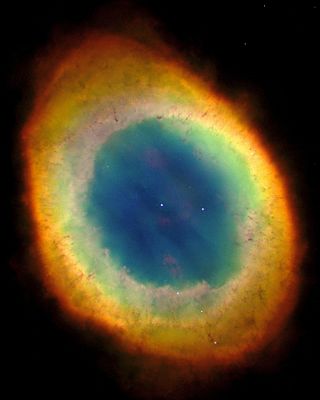
An emission nebula is a nebula formed of ionized gases that emit light of various wavelengths. The most common source of ionization is high-energy ultraviolet photons emitted from a nearby hot star. Among the several different types of emission nebulae are H II regions, in which star formation is taking place and young, massive stars are the source of the ionizing photons; and planetary nebulae, in which a dying star has thrown off its outer layers, with the exposed hot core then ionizing them.

Wolf–Rayet stars, often abbreviated as WR stars, are a rare heterogeneous set of stars with unusual spectra showing prominent broad emission lines of ionised helium and highly ionised nitrogen or carbon. The spectra indicate very high surface enhancement of heavy elements, depletion of hydrogen, and strong stellar winds. The surface temperatures of known Wolf–Rayet stars range from 20,000 K to around 210,000 K, hotter than almost all other kinds of stars. They were previously called W-type stars referring to their spectral classification.
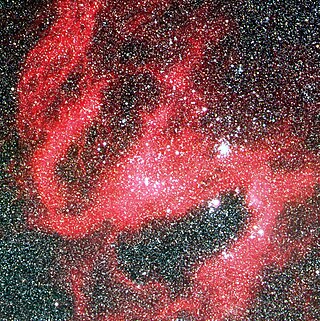
S Doradus is one of the brightest stars in the Large Magellanic Cloud (LMC), a satellite galaxy of the Milky Way, located roughly 160,000 light-years away. The star is a luminous blue variable, and one of the most luminous stars known, having a luminosity varying widely above and below 1,000,000 times the luminosity of the Sun, although it is too far away to be seen with the naked eye.
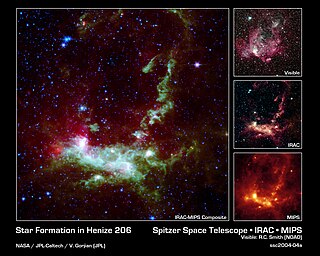
Henize 206 is a nebula in the Large Magellanic Cloud. This luminous cloud of gas and dust houses a cluster of newborn stars. Although Henize 206 was first catalogued in the 1950s, it was reported in NASA press releases in March 2004, for showing several example images generated from the various infrared cameras on the Spitzer Space Telescope launched in August 2003.

AB7, also known as SMC WR7, is a binary star in the Small Magellanic Cloud. A Wolf–Rayet star and a supergiant companion of spectral type O orbit in a period of 19.56 days. The system is surrounded by a ring-shaped nebula known as a bubble nebula.
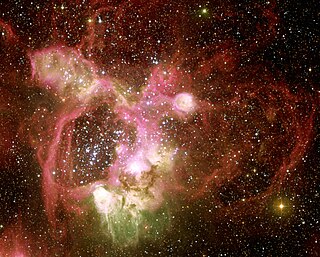
N44 is an emission nebula with superbubble structure located in the Large Magellanic Cloud, a satellite galaxy of the Milky Way in the constellation Dorado. Originally catalogued in Karl Henize's "Catalogue of H-alpha emission stars and nebulae in the Magellanic Clouds" of 1956, it is approximately 1,000 light-years wide and 160,000-170,000 light-years distant. N44 has a smaller bubble structure inside known as N44F. The superbubble structure of N44 itself is shaped by the radiation pressure of a 40-star group located near its center; the stars are blue-white, very luminous, and incredibly powerful. N44F has been shaped in a similar manner; it has a hot, massive central star with an unusually powerful stellar wind that moves at 7 million kilometers per hour. This is because it loses material at 100 million times the rate of the Sun, or approximately 1,000,000,000,000,000 tons per year. However, varying density in the N44 nebula has caused the formation of several dust pillars that may conceal star formation. This variable density is likely caused by previous supernovae in the vicinity of N44; many of the stars that have shaped it will eventually also end as supernovae. The past effects of supernovae are also confirmed by the fact that N44 emits x-rays.
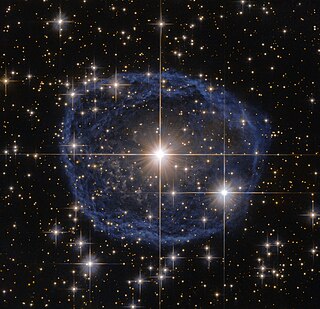
WR 31a, commonly referred to as Hen 3-519, is a Wolf–Rayet (WR) star in the southern constellation of Carina that is surrounded by an expanding Wolf–Rayet nebula. It is not a classical old stripped-envelope WR star, but a young massive star which still has some hydrogen left in its atmosphere.

AB8, also known as SMC WR8, is a binary star in the Small Magellanic Cloud (SMC). A Wolf-Rayet star and a main sequence companion of spectral type O orbit in a period of 16.638 days. It is one of only nine known WO stars, the only Wolf-Rayet star in the SMC not on the nitrogen sequence, and the only Wolf-Rayet star in the SMC outside the main bar.

N119 is a spiral-shaped H II region in the Large Magellanic Cloud. Its dimensions are large, at 131 x 175 pc. It contains several luminous stars including S Doradus, LH41-1042, and LMC195-1. Its peculiar S-shaped structure is difficult to explain with classical models.

R85 is a candidate luminous blue variable located in the LH-41 OB association in the Large Magellanic Cloud.
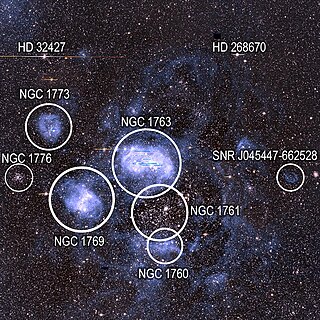
N11 is the brightest emission nebula in the north-west part of the Large Magellanic Cloud in the Dorado constellation. The N11 complex is the second largest H II region of that galaxy, the largest being the Tarantula Nebula. It covers an area approximately 6 arc minutes across. It has an elliptical shape and consists of a large bubble, generally clear interstellar area, surrounded by nine large nebulae. It was named by Karl Henize in 1956.

LHA 120-N 55 or N55 is an emission nebula located within the Large Magellanic Cloud (LMC). N55 is situated inside a superbubble called LMC 4. It is a glowing clump of gas and dust that gets its light output from the hydrogen atoms shedding electrons within it. It was named in 1956, in a catalogue of H-alpha emission line objects in the LMC.
LHA 120-S 79 is an RV Tauri variable star located in the Large Magellanic Cloud, located about 163,000 light years away in the constellation of Dorado, with a period of 37.203 days. The star is extremely hot for a star of its type, as its temperature is over 10,000 K, and it is hot enough to be classified as a B-type blue giant, as well as being the hottest RV Tauri variable in the LMC. LHA 120-S 79 is also extremely luminous, at over 14,000 L☉, and it is the most luminous known star of its type in the galaxy.

Hen 2-131 is a planetary nebula in the southern constellation of Apus. It was discovered by Andrew David Thackeray in 1950 and added to the Catalogues of Hα-emission Stars and Nebulae in the Magellanic Clouds by Karl Gordon Henize in 1967.

Henize 70 (N70) is a faint emission nebula and superbubble located in the Large Magellanic Cloud. It is located in the constellation of Dorado.














